Last week I neglected to mention that we drove by the kid's schools to show them to Bob and Lona. Kalle's school is well hidden so we only saw the front of the building. Fortunately we were able to see more of Karl's campus type school setup with a short drive so both trips were nice. I am a visual person myself so thought they would be interested in seeing the schools themselves. Bob especially liked the suit coat and tie uniform that Karl wears (we saw them on some kids walking around John Port).
On Tuesday we checked out Derby Cathedral Quarter for a breakfast place and then a couple of attractions. We would have seen more but I had to be at Kalle's school in the afternoon so it was a quick trip. For breakfast we ate at Jackrabbits across from the Cathedral which I found out about from Cindy when the BHC went there for lunch one time. Not exactly a US breakfast but much better than typical UK breakfast meals.
Dana Johnson Pic - Eggs, bacon (it's still really ham Dana), toast, rocket (green leafy weed stuff) and tomatoes. Passed with the Bob's Seal of Approval Stamp - thanks Cindy.
I digress but this cracks me up - apparently Carlsberg has some self esteem issues.
Second stop was Derby Cathedral (see previous blog trip link here). Again I won't cover much since I've already written about it once but I did learn a few new facts on this trip from the interesting docents.
Tower was open today. We'll be on the top in a few mouse clicks.
The wooden effigy on top dates to 1527 (medieval times). The small cadaver underneath still creeps me out.
Bess of Hardwick's memorial. We are going to Chatsworth later this week.
St. Katherine's Chapel was closed last time I was in here (Wiki link on Katherine) so I checked it out this time. Read some interesting literature on St. Katherine below. The 340 million year old stone is impressive I thought.
Not sure I want a flaming wheel firework named after me.
The cathedra or Bishop's Seat. Ever wonder what is the difference between a cathedral and a church? The cathedra of course! In each Bishop's area there is one church that has a cathedra which makes it a cathedral. Ever wonder why minsters aren't called churches or cathedrals? Because they have monks praying in them whereas churches and cathedrals don't. (Except for York Minster which is both a minster and cathedral as my smarty pants wife pointed out so I guess there are a few exceptions.) Thanks docents.
From the plaque - the old church was taken down in 1722/3 so a new church was built. The "firft" sermon was preached in the "new church" on November 21 1725 which led me to believe this pulpit was part of the old church and re-used in the "new church". More interesting to me was we are still 50 years from being a country and they are tearing down their old churches.
We parted with our three pounds and signed up for the 189 step tower climb but since we had a few minutes to spare before the narrow stepped circular tower climb we popped outside to our next stop, Ye Olde Dolphin Inn (see previous blog post here).
Ye Olde Dolphin Inne dating to 1530 AD. Building exterior is original according to the locals. Inside has been remodeled after being damaged by a fire.
Inside the Dolphin. You know a building is old when each room has its own fireplace.
Back to the cathedral and waiting for the climb to start. The wrought iron black and gold screen across the church is called the Bakewell Screen. It is named after the nationally famous wrought-iron craftsman named Robert Bakewell who made the screen.
Derby Cathedral bell trivia The oldest bell is from circa 1520 from a different plaque.
Derby Cathedral tower trivia. Now I've been in both of Derby's 1530 AD structures.
Here's your Word of the Week Auntie "B" - campanology.
The oldest peal of ten bells in the world.
The view from the top of the cathedral tower. Supposedly you can see three counties from here on a clear day but only two miles on a cloudy day.
Once we reached the top the docents pointed out all of the fog and then gave us a few more local and national trivia tidbits. One of the tidbits was that England has very strict flag laws. So on top of the cathedral tower roof is this St. Georges Cross pendant because a flag couldn't be flown here.
On Wednesday we went to Kedleston Hall (check out my previous Kedleston Hall blog post here). Kedleston is one of the nicer manor houses around and also within a day's trip distance so I brought Bob and Lona there to see it. I have to admit it was as impressive the second time as it was the first time. I won't go into the hall/family background since I covered it last time. Bob and Lona really enjoyed touring the hall and learning/seeing the history with their own eyes.
Front of the hall. Typical English winter day - overcast with occasional misting skies and cold winds. Temperature between cold and not warm enough.
Front "garden" looking out from the hall.
Tiger skin, he was laying on the billiards table the last time I was here.
Caesars Hall. All of the columns were added to support the Marble Room above. In a blog cross over Alex was with us today since he is out of school this week and needed a place to hang out while his parents were working.
I still find the cantilevered stairs fascinating. The hanging man was a dummy while the costumed man was explaining Victorian era hanging etiquette. Poor Alex would have been in the gallows with us, minimum hanging age then was seven years old.
The Marble Room. Marble floor and alabaster columns.
Between each pair of columns was statues on floor level and paintings above them. Above the painting were 3-D mythological beasts posing.
The Music Room.
Typically impressive fire places framed by marble.
Close up from the picture above. Not sure what to make of this bunch of angelic hooligans.
Check out the curved floor planks in this corridor.
The Withdrawing Room - where the women withdrew to after supper.
The couches are as impressive as I remember them.
As were the ceilings.
The doorways here reminded me of Versailles but not as opulent.
18th century reading chair. The book holder folded down so the men could sit close to a poker table.
Entrance to The Saloon. Not a great picture but if you look at the space in the doorway between the two doors that is how thick the block walls are per the docent. The walls here were about two and a half feet thick.
Nice sized mirror in a bedroom.
Interesting curved doorway in the same bedroom.
I think James Duke of York shown here is who New York is named after when the Brit took over New Amsterdam from the Dutch and renamed it New York.
Dining Room table.
This old lady was head servant and spoke a little about her duties and life in the hall during her time.
In a trophy room were artifacts taken from trips to India and Africa. This case is all ivory pieces.
Ivory chess pieces.
We also looked inside the church on the grounds.
Stained glass windows that reminded me of walking the Via Dolorosa in Jerusalem.
Sir John Curzon who died in 1406.
Not sure who St. Chad is on the bottom left but he has his own church I guess. On the upper left is St. Katherine who we learned about in the Derby Cathedral. Looks like her left arm is resting on her wheel.
From the docent: This doorway is the oldest part of Kedleston. It dates to 1130-1135 and was built by the Saxons. It is a copy of Roman architecture which was common of the Saxons since they were good soldiers but bad architects. The animal heads on the sides are wolf heads and are an example of Roman pagan images. The scene above the doorway was thought to have been of my buddies George and the Dragon but it was never fully carved into the stone. Speculation was that the mason may have died of the plague before completing the carving.
Outside view of All Saints Church.
View of back door of the hall. Pretty nice.
On Thursday it was a typically stellar English winter weather day so we were off again - this time to Chatsworth (read about our last trip to Chatsworth here). Kedleston and Chatsworth are the two local manor houses that are worth the price of admission. Bob and Lona liked both places (obviously) but strangely enough Bob liked Kedleston better and Lona liked Chatsworth better. IMO (in my opinion for the lame-o-s) Chatsworth is better but enough blather so onto the pictures.
The main complex from the road. Cows in front, sheep in background; we saw the deer as well but the view wasn't picture worthy. We toured the building on the right. On the upper left in the trees is the hunting lodge.
Sample marble floor.
Ceiling in the main corridor.
This cracked me up.
Impressive carving from the Oak Room.
Front of The Chapel.
Beautiful bust on a pedestal.
The main corridor.
One of the stairways.
Fireplace in the Great Chamber. Note the animals are hung upside down signifying that the person in the middle was a mighty hunter.
Wall tapestry in the Drawing Room.
A Da Vinci painting from 1503-04 showing Leda and the Swan from Greek mythology (from the room literature).
Just a case of gilded bowls and plates and stuff.
Pictures adorning the walls in another stairway.
Pink urn that captured my eye.
Bed from one of the guest bedrooms. One thing that surprised me about this house was how unimpressive the beds looked. Looks okay but not as impressive as some places we have seen.
I loved this painting for some reason.
The Cascade surrounded by the fall colour.
The Study.
A veiled lady, one of the many eye catching sculptures.
Per the literature - the forks turned over is the French style from the early 1800's. Why you ask? Because the rich Frenchies were all wearing long sleeved frilly tops and the forks turned up would catch on their foofy wristed tops so they were all turned tines down.
Slap some gold leafs on this door and we are starting to rival the Versailles Palace doorways.
The sculpture room. This reminded me of when we first started this exciting adventure and Chatsworth was one of the first places we toured and Kalle kept complaining about the inappropriate (nude) artwork. We've seen so much "inappropriate" artwork it doesn't faze any of us anymore.
Mars and Cupid.
The Cymbal Player. Maybe hard to see in the picture but such impressive detail/texture on the goat skin and tree stump.
The Stables - it's time for lunch so off to the restaurants.
I'm sure everyone feels like this some days.
Not Bob's favourite soup (his family will get the joke).
Dana Johnson Pic - cheesecake with cherry topping on left (okay but strong cheese flavor) and jacket potato with cheese and butter on right (tasted pretty good). Bob had the same thing and it qualified for his short list of favourite meals since he crossed the pond. You know the food is bad when a couple of other items on his list were meals I cooked.
After Chatsworth we drove to Chesterfield's Crooked Spire (quick pic and explanatory blurb here) to see it ourselves (thanks for the idea from your blog Steve). We found it and took a few minutes to admire the curiosity before piling back into the car clown style (not really) and driving down to Ashbourne (see here for previous blogged trip to Ashbourne) where we drove past the market place, gallows frame, and Shrovetide football field before heading home.
The Crooked Spire close up.
Crooked Spire and church.
Jim Seppanen Pic - driving through the beautiful southern Peak District. Tonnes of great views (rolling hills dotted with sheep and lonely farms, hedge and rock wall fenced-in pastures, horses and cattle lazily munching away, wooded dales changing colour, whole villages sitting in wooded valleys, tiny villages comprised of olden brown blocked buildings, brown scrubbed vegetation hilltops, I could go on and on...) but no pics as I was driving - sorry.
On Friday we stayed in the local area and looked at some older sights. First stop was St. Wystan Church (link) in Repton, home of an 8th Century crypt. The site has been used for Christian worship since 653 AD Repton was the capital of Mercia (Wiki link), a kingdom from the 500's to the 900's.
St. Wystan on left, neat archway on right. The tower and spire were built in the 15th Century, you can read the "Our Church" link on the website to see the building construction time line.
Crypt background.
More impressive stained glass.
The stairway down to the crypt.
An 8th Century crypt. Remember when Geraldo busted into Al Capone's vault? Kind of the same feeling I had here but still kind of neat considering how old it is. Worth a ten minutes stop on the way to The Bull's Head for the locals IMO.
From Wiki: St. Diuma was a Bishop of Mercia, St. Tristan may be from Brittany in France (remember that Great Britain used to be called Greater Brittany and northwest France used to be called Lesser Brittany when Saxons ruled Britain), St. Guthlac was from Mercia and served as a monk at the Repton Monastery, and St. Chad was from Mercia and is credited with introducing Christianity to the area. We saw him in Kedleston this week and he was holding a building there also but I am not sure what building he is holding.
A modern narrowboat (Wiki narrowboat link), or English canal boat. This one has was powered by a motor, they used to be pulled by horses who walked alongside the canal.
View of docked narrowboats along Mersey Canal in Willington.
After Willington was a ride through the Rolls Royce complex for Bob and Lona to see the massiveness of it and then back to Littleover for a stop at St. Peter's Church. It is the Church of England church that we sometimes attend so we stopped for the Norman Door and original stained glass windows/walls.
Early 14th Century stained glass. This glass and wall (and a couple other walls) are thought to be original construction dating to about 1340 AD.
The Norman Door, dating to 12th century.
View down nave of church. The far end is the original part of the building. You can see the Norman arch architecture along the sides and at end.
Stained glass close up.
A rare close up of a smaller stained glass section. Usually I go for the larger, colourful windows but Bob pointed this out to me and I thought I would include it as a simpler window example.
My Latin is a little rusty but I can make out 1635 AD.
Okay, now I am done until after holiday. See y'all in a few weeks.
Thanks for listening,
Jay







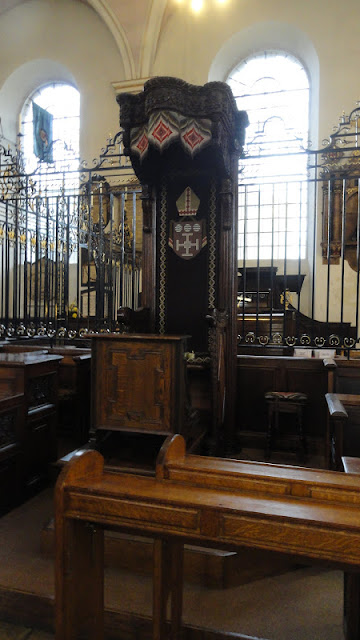













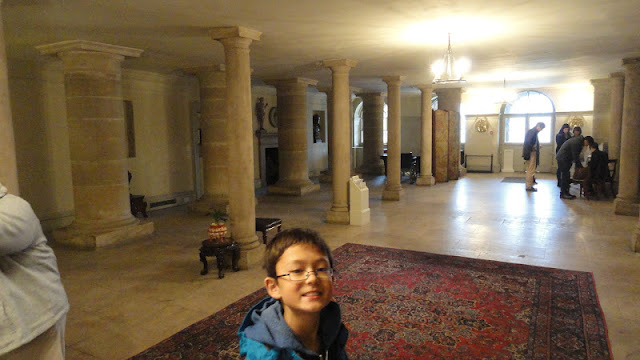

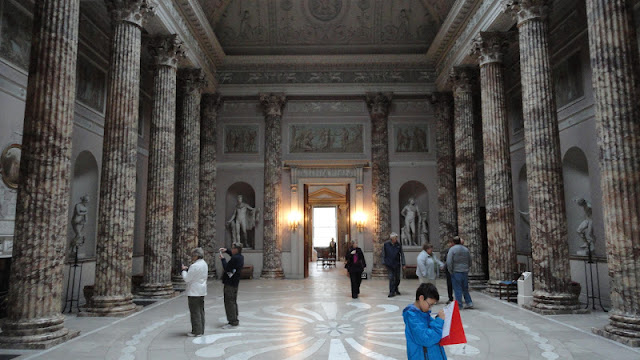

































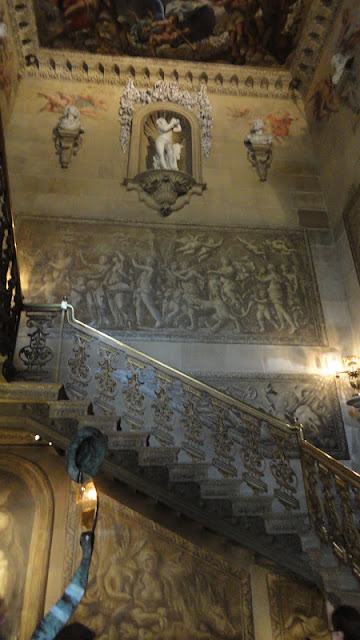

















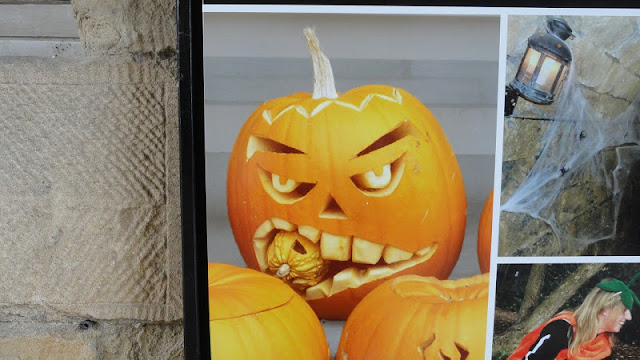



















No comments:
Post a Comment